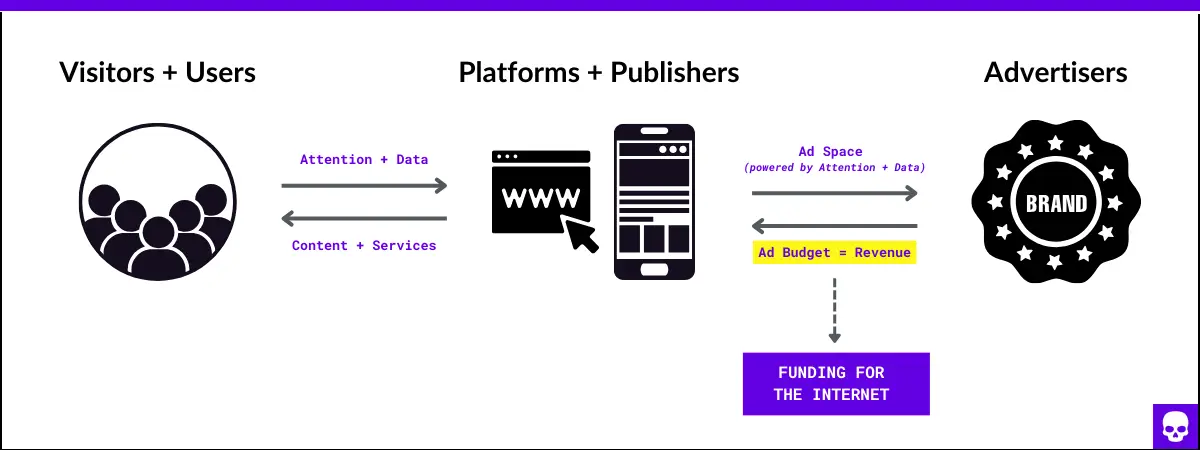While writing MadTech Convergence, I had a feeling that I should devote a few entries to the role of ads in the internet economy and the primary dynamics that have led to the current state of the industry. I’m of the opinion that many in the general online population aren’t explicitly aware that the internet is largely funded by ads. I think most recognize advertising from the marketer angle (ie. ads help brands sell stuff), but pay less attention to how publishers and content creators benefit/rely on the money coming in from marketers.
To confirm, I ran polls asking this question on LinkedIn and Twitter. Here are the results (polls ran from 10/31/23 – 11/06/23):

The combined survey results indicate that most respondents felt similarly. Of the 184 respondents, over half (51%) believe that fewer than a quarter of internet users are aware that ads support the internet. Additionally, a sizeable majority (78%) think that less than half of internet users are conscious of this fact.
Despite the limited sample, I felt the results justified spending some time to explain the subject. Obviously this material will be remedial for industry folks (at least it better be!), but it could be useful for friends and family who don’t live this stuff everyday. If so, please pass along!
Note
This and sequel entries are titled “Model 0.x” as they’re not explicitly about MadTech, but rather the economies and dynamics that MadTech underpins.
Ads pay for the internet

And it’s not just the whales. A large percentage of publishers rely on advertising to stay in business as well. According to a recent Digiday survey of over 200 publishers, the top 4 ranking revenue sources were all forms of advertising. And this shouldn’t come as a surprise as there’s no technological free lunch. Now are there too many ads on the internet? Yes I think so, but that’s a larger topic that we’ll tackle in a future post. For now, the thing to know is that something needs to pay for servers, engineers, content creators, journalists, etc. that keep things up and running. More often than not, that thing is advertising.
Even companies whose core revenue streams are from other areas such as Amazon, Uber and Netflix have built advertising businesses. While their business contexts differ, the goal of boosting incremental revenue and profit margin is shared. These days, with data privacy concerns and legislation diminishing the presence of legacy, unconsented online identifiers (e.g. 3rd party cookies), businesses with a scaled audience base, unique customer data, and sufficient ads surface area are finding the prospect of launching an advertising business increasingly practical and attractive. The internet’s implicit value exchange is that users pay for free services and content not with money, but with their attention and data. Tying this to advertising, the former is currency, the latter is fuel. This is why platform algorithms are designed to maximize the time users spend using an app/service. This influences everything from which LinkedIn posts generate the most views, to why YouTube and Twitch pay content creators such huge sums. The longer users spend using a service or engaging with content, the more digital real estate there is for ads, which leads to greater revenue. This concept applies to almost any ad supported online service. The diagram is a simplified illustration of this dynamic

Challenges and user perceptions of online ads
- Low quality ads and/or ad experience – A core dynamic of the internet is that there is limited demand (user attention) relative to near-infinite supply (ad space). This coupled with the economic incentive for industry players to maximize revenue (ie. deliver more ads) has led to many of the challenges plaguing the industry when it comes to user experience (e.g. ad clutter, pop-ups, auto-play video ads, etc.)
- Lack of control over ad content – Given how data is used to personalize ads, different users in the same context can be served different ads based on their online (and sometimes offline) behaviors. If done right, this can make ads more relevant and/or useful. When poorly executed, this leads to poor ad experiences (e.g. ads following you around, seeing the same ad over and over, etc.) and a perceived lack of control of how and when ads are delivered to users.
- Poor communication of the value exchange – Are you aware of the value exchange described above? If not, you’re not alone. Many in the industry (including me) believe that we’ve done a poor job of communicating this value exchange to internet users over the years. This oversight has resulted in several negative downstream consequences, contributing to an ambient distrust of online ads for some.
- Cognitive Dissonance – A personal theory is that the on-demand nature of the internet means that users are accustomed to being able to access the content they want whenever they want it. As such the presence of ads interrupting that experience can result in greater comparative annoyance relative to TV or radio, where ads occur in “expected” places and intervals.
Given their depth and complexity, we’ll dive deeper into the core dynamics that have lead to some of the above factors in a future post. Specifically, we’ll discuss the following:
- Why there are so many ads on the internet (and why some of them suck).
- Why everyone on the internet is asking for your data.



